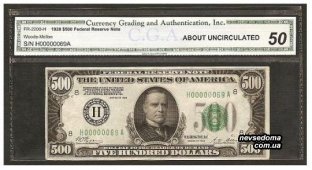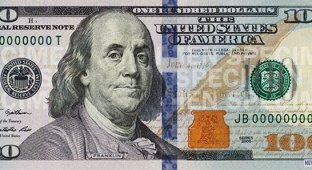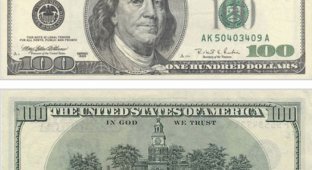Try asking one of your friends traveling to the US to bring you a $2 bill. Most likely, upon their return, they will tell you that they have never seen such people at all, or that they do not exist. Despite the fact that the $2 bill has been part of the standard set of banknotes throughout US history, it is very difficult to find it in free circulation.

For purely psychological reasons, this banknote, having appeared in circulation, is immediately withdrawn from it and transferred to the wallets of citizens, exported abroad, sold at auctions, and resold to numismatists.
What is the reason? The reason, probably, is a whole series of myths associated with this bill, “bringing happiness and success.”
The $2 bill, issued in 1976 to commemorate the US Bicentennial, is considered rare by many collectors. And how can one not consider it that way, even if in the serious reference book “From the dollar to the yen. A Guide to the World's Currencies, released in 1995 and commissioned by leading commercial banks, states that “two-dollar bills... were issued in small quantities, and not all Americans held them in their hands.”
The denomination of the two dollar bill is familiar to America - it has been used in US monetary circulation since time immemorial. This bill was already included in the set of banknotes of the first issue, issued in Philadelphia on May 10, 1775. Two-dollar bills were then issued by individual states: in Maryland - since 1770, in New York and North Carolina - since 1775, in Georgia and New Hampshire - since 1776. etc. During the Civil War 1861-1865. many states also issued their own money, including two-dollar bills.

The first two dollar bills were issued by the US Federal Government in 1862. They depicted a portrait of the first Secretary of the Treasury, Alexander Hamilton. However, already in 1869, this portrait was replaced by the image of the third US President and author of the Declaration of Independence, Thomas Jefferson. However, initially two-dollar bills were not popular with banks and the public. There are several explanations for this, the most common being that most cash registers did not have a separate place for $2 bills. Apparently this explanation makes some sense. For the same reason, say, 5 mark banknotes were not popular in Germany.

It is believed that two-dollar bills were easily confused with $1 bills, and this also entailed some inconvenience. In addition, the popular belief has spread that $2 bills bring bad luck. All this led to the low prevalence of banknotes. The situation reached the point of absurdity when merchants refused to accept two-dollar bills in stores.
In Russia, there are still cases of refusal to accept two-dollar bills by exchange offices, citing the fact that there is no properly executed sample of these bills, especially the anniversary series.
The last time the dollar underwent a major redesign was in 1928 - the sizes of all banknotes were reduced, and their appearance was standardized and, with minor changes, has been preserved to this day. Among the banknotes of this type, a two-dollar bill is also issued.

Its front side depicts Thomas Jefferson (1743-1826), a prominent statesman and public figure, the “father” of the Declaration of Independence, the 3rd President of the United States.
The reverse side of the 1928 banknote depicts Jefferson's estate, Monticello (from the Italian for "Little Mountain"). It was built according to his own design. The house was replete with various technical improvements, including those developed by the owner himself. Here the “sage from Monticello” lived his last 17 years, here he received numerous guests, conducted extensive correspondence - over a thousand letters a month - with many American and European politicians, scientists and public figures.
His library at Monticello numbered about six and a half thousand volumes and was one of the best in America. She laid the foundation for the Library of Congress. Since 1926 Monticello is a memorial museum and a national shrine of the United States. It is interesting to note that Jefferson's portrait and estate are also depicted on the front and back of the American nickel, a 5-cent coin.

On the supposedly “rare” 1976 $2 bill. Jefferson is also depicted. The reverse side depicts the adoption of the Declaration of Independence. This drawing is a reproduction of the painting “The Signing of the Declaration of Independence” by the famous American artist J. Trumbull, one of the eight huge canvases hanging in the Capitol Rotunda. It depicts the meeting of the Continental Congress on July 4, 1776, which proclaimed the separation of the 13 North American colonies from Great Britain.
The painting depicts the specific moment when Jefferson, along with four other members of the committee that drafted the Declaration of Independence, presents the draft of the Declaration to the President of the Continental Congress, Hancock (seated in the chair on the right) for his signature. The painting depicted 48 people, but only 44 of them fit on the banknote. Moreover, 36 characters were painted by the artist during his lifetime.

Thomas Jefferson was only 33 years old at the time of the Declaration, which is how he is depicted in the painting. After this event, he lived (day after day!) for another fifty years, was the governor of Virginia, secretary of state, i.e. Minister of Foreign Affairs, Vice President, President (under him, by the way, diplomatic relations with Russia were established in 1808-1809). On the obverse of the two-dollar bills he is depicted as a mature statesman, apparently from the period of his presidency (the portraits on 10 of the 12 American banknotes of various denominations are portraits of presidents).

1976 two dollar bill was printed in millions of copies. But, obviously, the population of the United States is somehow not satisfied with banknotes of this denomination. The most popular is the one dollar bill, which accounts for 47% of the total number of banknotes in circulation. Its average “life expectancy” is only a year and a half, during which time it turns from a crisp bill into crumpled and torn paper that needs to be replaced.
And every day, the New York Federal Bank alone shreds more than $35 million worth of worn-out one-dollar bills! And a huge stockpile of unclaimed “rare” 1976 two-dollar bills. lies uselessly in the Treasury. Obviously, these bills are not in circulation, do not wear out, and, accordingly, do not need to be replaced.
There are a number of legends regarding the “that dollar” bill. According to one of them, if you have this bill in your wallet, then money will not be transferred into it. Well, numismatists already have a professional interest in this bill. After all, what is difficult to find in circulation always attracts the attention of numismatists.
Another legend has some sexual context. During the Vietnam War, the services of a Vietnamese prostitute usually cost $2. If attempts were made to pay with 5, then change was usually not found. As a result, 2 dollars also became a symbol of inexpensive and high-quality sexual services.

























